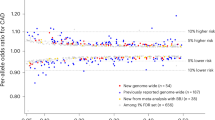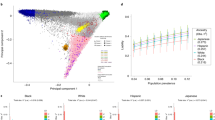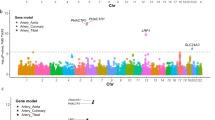Abstract
Diseases of the vascular system result from a complex mixture of genetic and environmental factors. Data sets, technologies and strategies emanating from the human genome programme have been applied to the analysis of both rare single-gene and common multigenic vascular disorders. Genomic approaches including inter- and intraspecies sequence comparisons, genotyping with dense marker sets spanning the genome, large-scale mutagenesis screens of model organisms, and genome-wide expression profiling have all begun to contribute to the identification of new genes and mechanisms that are central to cardiovascular disease processes.
This is a preview of subscription content, access via your institution
Access options
Subscribe to this journal
Receive 51 print issues and online access
$199.00 per year
only $3.90 per issue
Buy this article
- Purchase on Springer Link
- Instant access to full article PDF
Prices may be subject to local taxes which are calculated during checkout




Similar content being viewed by others
References
Sanger, F., Nickeln, S. & Coulson, A. DNA sequencing with chain-terminating inhibitors. Proc. Natl Acad. Sci. USA 74, 5463– 5467 (1977).
Maxam, A. & Gilbert, W. A new method for sequencing DNA . Proc. Natl Acad. Sci. USA 74, 560– 564 (1977).
Loots, G. G. et al. Identification of a coordinate regulator of interleukins 4, 13, and 5 by cross-species sequence comparisons. Science 288, 136–140 (2000).
Göttgens, B. et al. Analysis of vertebrate SCL loci identifies conserved enhancers. Nature Biotechnol. 18, 181– 186 (2000).
Mayor, C. et al. VISTA: visualizing global DNA sequence alignments of arbitrary length. Bioinformatics (in the press).
Porcher, C. et al. The T cell leukemia oncoprotein SCL/tal-1 is essential for development of all hematopoietic lineages. Cell 86, 47–57 (1996).
Robb, L. et al. The scl gene product is required for the generation of all hematopoietic lineages in the adult mouse. EMBO J. 15, 4123–4129 (1996).
Lifton, R. P. Molecular genetics of human blood pressure variation. Science 272, 676–680 (1996).
Bodzioch, M. et al. The gene encoding ATP-binding cassette transporter 1 is mutated in Tangier disease. Nature Genet. 22, 347 –351 (1999).
Brooks-Wilson, A. et al. Mutations in ABC1 in Tangier disease and familial high-density lipoprotein deficiency. Nature Genet. 22, 336–345 (1999).
Rust, S. et al. Tangier disease is caused by mutations in the gene encoding ATP-binding cassette transporter 1. Nature Genet. 22, 352–355 (1999).
Collins, F. S., Guyer, M. S. & Charkravarti, A. Variations on a theme: cataloging human DNA sequence variation. Science 278, 580– 581 (1997).
Risch, N. & Merikangas, K. The future of genetic studies of complex human diseases. Science 273, 1516–1517 (1996).
Lander, E. S. The new genomics: global views of biology. Science 274, 536–539 (1996).
Nickerson, D. A. et al. DNA sequence diversity in a 9.7-kb region of the human lipoprotein lipase gene. Nature Genet. 19, 233– 240 (1998).
Rieder, M. J., Taylor, S. L., Clark, A. G. & Nickerson, D. A. Sequence variation in the human angiotensin converting enzyme. Nature Genet. 22, 59–62 (1999).
Halushka, M. K. et al. Patterns of single-nucleotide polymorphisms in candidate genes for blood-pressure homeostasis. Nature Genet. 22, 239–247 (1999).
Kreutz, R. et al. Dissection of a quantitative trait locus for genetic hypertension on rat chromosome 10. Proc. Natl Acad. Sci. USA 92, 8778–8782 (1995).
Jacob, H. et al. Genetic mapping of a gene causing hypertension in the stroke-prone spontaneously hypertensive rat. Cell 67, 213–224 (1991).
Stoll, M. et al. New target regions for human hypertension via comparative genomics . Genome Res. 10, 473–482 (2000).
Mu, J. L. et al. Quantitative trait loci analysis for the differences in susceptibility to atherosclerosis and diabetes between inbred mouse strains C57BL/6J and C57BLKS/J. J. Lipid Res. 40, 1328– 1335 (1999).
Zhang, S. H. et al. Spontaneous hypercholesterolemia and arterial lesions in mice lacking apolipoprotein E. Science 258, 468 –471 (1992).
Plump, A. S. et al. Severe hypercholesterolemia and atherosclerosis in apolipoprotein E-deficient mice created by homologous recombination in ES cells. Cell 71, 343–353 ( 1992).
Ishibashi, S. et al. Massive xanthomatosis and atherosclerosis in cholesterol-fed low density lipoprotein receptor-negative mice. J. Clin. Invest. 93, 1885–1893 ( 1994).
Dansky, H. et al. Genetic background determines the extent of atherosclerosis in apoE-deficient mice. Arterioscler. Thromb. Vasc. Biol. 19, 1960–1968 (1999).
Amsterdam, A. et al. A large-scale insertional mutagenesis screen in zebrafish . Genes Dev. 13, 2713–2724 (1999).
Vitaterna, M. H. et al. Mutagenesis and mapping of a mouse gene, Clock, essential for circadian behavior. Science 264, 719 –725 (1994).
Lee, R. K. et al. Cardiovascular development in the zebrafish. II. Endocardial progenitors are sequestered within the heart field. Development 120, 3361–3366 ( 1994).
Stainier, D. Y., Lee, R. K. & Fishman, M. C. Cardiovascular development in the zebrafish. I. Myocardial fate map and heart tube formation. Development 119, 31–40 (1993).
Zhong, T. P. et al. gridlock, an HLH gene required for assembly of the aorta in zebrafish. Science 287, 1820– 1824 (2000).
Weinstein, B. M. et al. Gridlock, a localized heritable vascular patterning defect in the zebrafish. Nature Med. 1, 1143– 1147 (1995).
Nolan, P. et al. A systematic, genome-wide, phenotype-driven mutagenesis programme for gene function studies in the mouse. Nature Genet. 25, 440–443 (2000)
deAngelis, M. et al. Genome-wide, large-scale production of mutant mice by ENU mutagenesis. Nature Genet. 25, 444– 447 (2000).
The chipping forecast. Nature Genet. 21(Suppl.), 1–60 (1999).
Lawn, R. M. et al. The Tangier disease gene product ABC1 controls the cellular apolipoprotein-mediated lipid removal pathway. J. Clin. Invest. 104, R25–R31 ( 1999).
Aitman, T. J. et al. Identification of Cd36 (Fat) as an insulin-resistance gene causing defective fatty acid and glucose metabolism in hypertensive rats . Nature Genet. 21, 76– 83 (1999).
Rust, S. et al. Assignment of Tangier disease to chromosome 9q31 by a graphical linkage exclusion strategy. Nature Genet. 20, 96–98 (1998). [Published erratum appears in Nature Genet. 20, 312 ( 1998).]
Hayden, M. R. et al. Cholesterol efflux regulatory protein, Tangier disease and familial high-density lipoprotein deficiency. Curr. Opin. Lipidol. 11, 117–122 ( 2000).
Reaven, G. M., Banting lecture 1988. Role of insulin resistance in human disease. Diabetes 37, 1595–1607 ( 1988).
Friddle, C. et al. Expression profiling reveals distinct sets of genes altered during induction and regression of cardiac hypertophy. Proc. Natl Acad. Sci. USA 97, 6745–6750 (2000).
Stanton, L. et al. Altered patterns of gene expression in response to myocardial infarction. Circ. Res. 86, 919– 920 (2000).
Gelfand, M. S., Koonin, E. V. & Mironov, A. A. Prediction of transcription regulatory sites in Archaea by a comparative genomic approach. Nucleic Acids Res. 28, 695–705 (2000).
Koonin, E. V. & Galperin, M. Y. Prokaryotic genomes: the emerging paradigm of genome-based microbiology. Curr. Opin. Genet. Dev. 7, 757–763 ( 1997).
Author information
Authors and Affiliations
Corresponding author
Rights and permissions
About this article
Cite this article
Rubin, E., Tall, A. Perspectives for vascular genomics. Nature 407, 265–269 (2000). https://doi.org/10.1038/35025236
Issue Date:
DOI: https://doi.org/10.1038/35025236
This article is cited by
-
Cardiovascular Genetic Medicine: The Genetics of Coronary Heart Disease
Journal of Cardiovascular Translational Research (2008)
-
A possible mechanism of unilateral hippocampal stroke after bilateral occlusion of the common carotid arteries in rats with different types of behavior
Neuroscience and Behavioral Physiology (2007)
-
Cardiovascular genomics
Stem Cell Reviews (2006)
-
The many faces of tumor necrosis factor in stroke
Nature Medicine (2002)
-
Application of Physiological Genomics to the Microcirculation
Microcirculation (2002)
Comments
By submitting a comment you agree to abide by our Terms and Community Guidelines. If you find something abusive or that does not comply with our terms or guidelines please flag it as inappropriate.



